Chrysler’s original Hemi V8 engines were small, for V8s, but produced a great deal of power. They were replaced by big wedge engines, but lived on in the A series, which had cheaper-than-hemi “polyspherical” heads, and then by the LA engines—which, with a cheap wedge-head design, were engineered for mass production but not high performance. The 340 cubic inch version of the LA series was a definite exception.
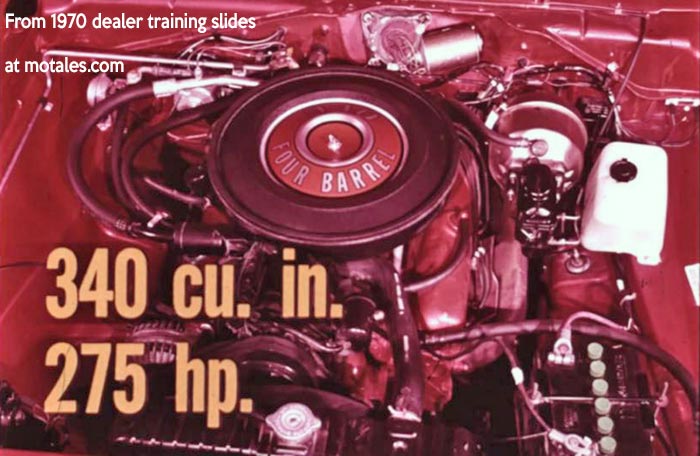
With high-flow heads, bigger ports, and a choice of four-barrel or a trio of two-barrel carburetors, the 340 produced a great deal of power for its size—making it a fine alternative to the heavy 383 V8, and a good choice for the compact Plymouth Duster and Dodge Dart GT (among other cars). One source claimed that the impetus for the engine was likely the 350-horsepower Chevrolet 327; Willem Weertman, head of engine design, credited the 1968 Plymouth Barracuda Formula S and Dodge Dart GTS (both views are likely true).

Tom Hoover guided the design, as he had led creation of the 426 Hemi. He maximized the bore, setting it to 4.04 inches; to make the valves larger, he moved the spark plugs further out, by 0.08”. Willem Weertman called it a “daring” move, since the cylinders were 4.46 inches apart; but it worked. The 340, in the company’s compact cars, was a hot engine indeed—the only small block in the Dodge “Scat Pack.”
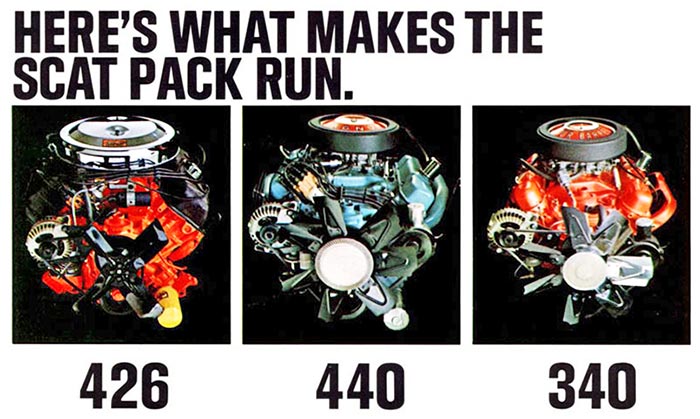
In the model-year it was launched—1967—the differences between the 340 and the then-largest-LA V8, the 318, included:
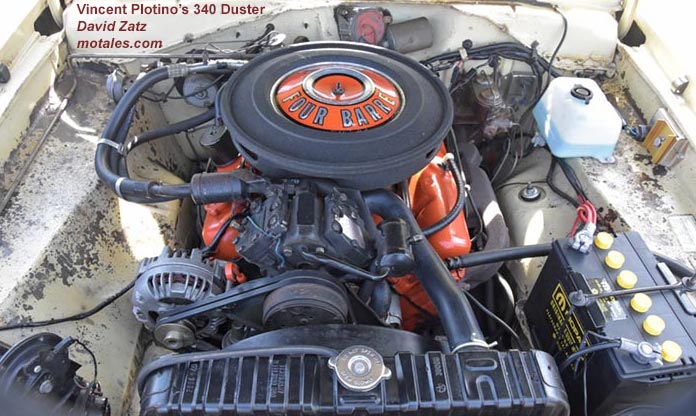
Even the valve covers were different, because the carburetor was wider; its linkages interfered with the spark plug wires, so the engineers made the driver’s-side wire holder about 2.5" higher. On the passenger side, the choke well boss was closer to the wiring and vacuum advance hose; the engineers added a rubber-coated, curved heat shield to protect them. These changes from the 318’s covers are easily visible. (When the T/A was launched, the spark plug wire holders were moved about an inch to the back.)
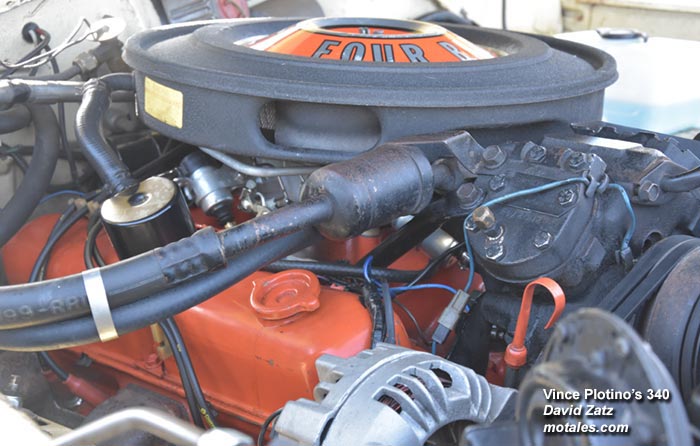
“Fast Eddie” Poplawski, who did some of the original dynonometer development, said that the Carter AVS four-barrel version of the engine would run 230-330 horsepower at 6,000 rpm, without an air cleaner, accessories, muffler, and such, and with special tuning. It was advertised at 275 hp, to make it more competitive in NHRA stock racing. That 275 hp was 45 hp more than the 318 V8 with its two-barrel carburetor.
| 1968 specs | 318 V8 |
340 V8 |
|---|---|---|
| Carburetor | Carter BBD 2-bbl | Carter AVS 4-bbl |
| BHP | 230 @ 4400 rpm | 275 @ 5000 rpm |
| Torque | 340 @ 2400 rpm | 340 @ 3200 rpm |
| Compression | 9.2 to 1 | 10.5 to 1 |
| Bore x Stroke | 3.91 x 3.31 | 4.04 x 3.31 |
| Fuel | Regular | Premium |
Was 275 bhp accurate? After all, it was a slightly bigger engine, and produced 45 bhp more. It turns out, based on Steve Magnante’s 2017 story in Hot Rod, that Chrysler almost certainly underrated these engines. R.A.D. Auto Machine assembled a “nearly stock specification” 340 and tested it with both four and six barrel setups. With the factory four-barrel setup, they ran 320 bhp and 368 lb-ft of torque. That’s a good 45 bhp gain (with an extra 28 lb-ft of torque), but was that the end? Remember, bhp was measured without factory exhaust, so they replaced the manifolds with headers and saw 352 bhp and 396 lb-ft of torque, the latter peaking at 3,200 rpm as the factory stated... but that was 77 bhp and 56 lb-ft more than they published, and enough to pound Chevrolet, Ford, and AMC 350, 351, and 360 engines into oblivion. (The main change from stock, because it was a rebuild, was a slight bore-out from 4.04” to 4.080”; they also used slightly lighter pistons and rods, which may throw off the numbers slightly.)
Magnante noted that these numbers are far more consistent with actual performance than the published figures; he thought the published power ratings were meant to show a performance gap against the 383 powered B-bodies, which were far more profitable.
For the 1969 model year, all 340s used the 1968 automatic-transmission cam, rather than having a separate one for the manual transmissions.
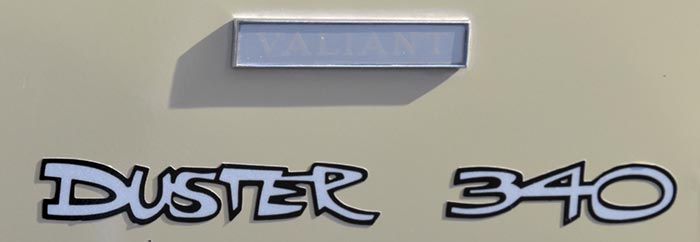
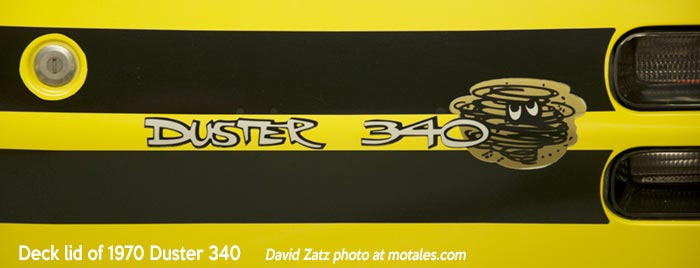
Special 1970 Challenger T/A and Barracuda AAR models were sold by dealerships because the Sports Car Club of America (SCCA) demanded that cars running in the Trans Am series be based on stock cars. Chrysler created a few thousand triple-Holly-carburetor versions of the 340 for street-legal cars. Since the racing car produced around 440 bhp, using a Keith Black-built engine with a smaller bore and single four-barrel carburetor, the logic of the homologation is unclear, but it worked.
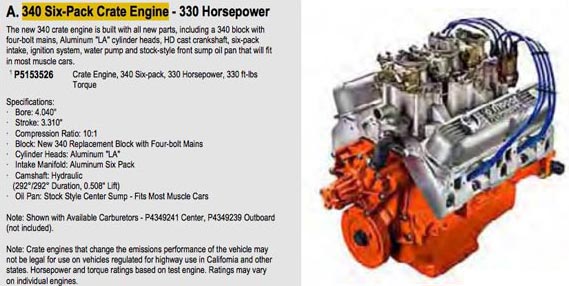
This was not the company’s first triple-carb setup; the 440 had a “six-barrel” option for Plymouth and Dodge starting in the 1969 model year, generating an impressive 390 bhp with 490 lb-ft of torque. Both used Holley two-barrels. This was, though, the only Chrysler use of a triple-carb setup on a small block V8 (an even smaller engine enjoyed three carburetors—Webers—on Chrysler’s Australian six-cylinders).
It might seem as though changing out the carburetor setup would be easy, needing only a new intake manifold and linkage, but the changes turned out to be quite severe. The triple-carburetor setup, trademarked as Six-Pack by Dodge and called “six-barrel” by Plymouth, only started with the three carburetors on an aluminum Edelbrock intake manifold. Blocks were stress-relieved and had higher nickel content than usual. The heads had “J” castings (some 1970 versions had a U or O casting letter in addition to the J, but with the same part number). The rocker arm/shaft/pushrod assembly was unique to this engine (but similar to the W2 design). Airflow was increased with oversized head porting and a huge, unsilenced air cleaner replacing the usual double-snorkel air cleaner; to prevent running lean, big 3/8” fuel lines completed the engine package.
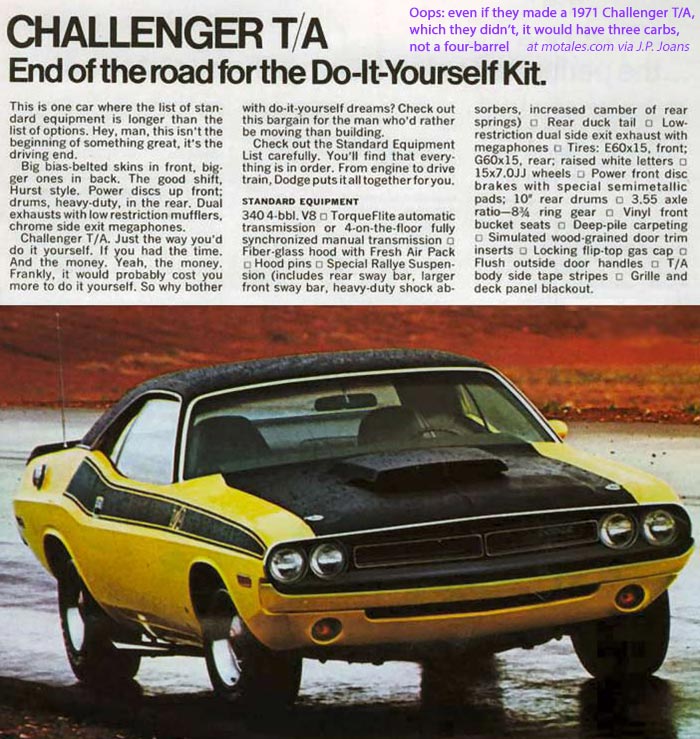
To handle the extra power, bulkheads were beefed up, webs thickened, and four-bolt main bearing caps used on some cylinders; the intake valve pushrod holes were offset and valve covers were altered somewhat. A fiberglass hood reduced weight a bit (some lifted off and some had hinges).
The retail versions were announced in January 1970 and produced a few months later. It appears that all the cars and engines were produced in March and April 1970. Buyers could choose a four-speed manual or three-speed automatic transmission, with 3.55:1 or 3.91:1 gears, and a limited-slip differential. The suspension used special shocks and rear springs to provide nearly two more inches of clearance for the exhaust pipes (poking out before the rear tires); they were the country’s first assembly-line-produced car with different sized tires in front and rear (G60x15 rear, E60x15 front).

With all this work, the claimed power was just 290 bhp and 345 lb-ft of torque, a seemingly minor increase. However, power and torque numbers were not always quite as believable as in later years; for one thing, they suspiciously tended to end with a 0 or a 5 in just about every case. Tom Quadrini, in Classic Chrysler Quarterly, estimated the true output at 325 bhp. The Challenger T/A and AAR ’Cuda could run a 14.3-second quarter mile, regardless of stated power figures; and Car & Driver found a 0-60 time of just 5.8 seconds, reinforcing the idea that the power ratings were considerably higher than stated. When Hot Rod took a Six-Pack 340 configuration to the dyno, they measured 356 bhp and 382 lb-ft with stock manifolds, and 376 bhp and 409 lb-ft of torque with headers. Chrysler was quite clearly understating the extreme output of these hot V8s.
All that engineering also did not last long in time—the Challenger T/A and AAR ’Cuda did not achieve much success in racing. The company made, depending on the source, 2,400; 2,800; or roughly 4,000 E-body 340-three-carb cars. Most sources, including the Standard Catalog of Dodge Cars, show that no 1971s were made; a 1971 model year was planned, but not executed, as Chrysler did poorly in the Trans Am races and pulled out after just one season. There were still ads for the 1971s, because it takes time to cancel magazine ads.
The 1971 cars had a very slight drop in compression, to 10.25:1, but horsepower was unchanged. However, the way power was measured switched to SAE standards which included oil and water pumps, alternators, factory exhausts, and such—which had not been attached to the engine to get bhp or “gross” ratings. The new SAE or “net” ratings were therefore lower, for the same engines. How much lower, you may ask? The 340 reportedly “lost” 40 hp and 20-35 lb-ft of torque solely due to the change in measurement. (It’s hard to be sure, since the numbers were still suspiciously round afterwards, suggesting that the 340 was either more or less powerful than the official ratings suggested.)
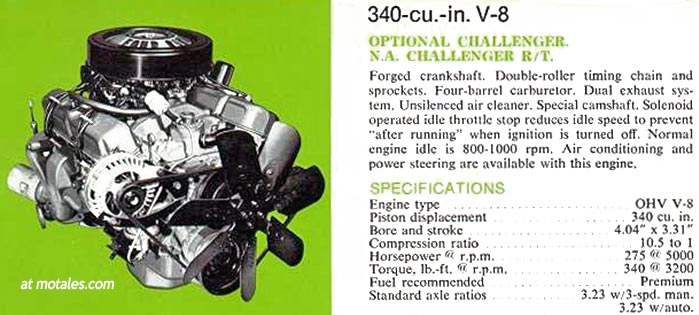
The sole carburetor was now the Carter Thermoquad, successor to the AVS, rated at 850 cfm. New heads, confusingly also coded as the “J” casting but not the ones used on the T/A in 1970, replaced the X heads; these kept the 2.02” intake valves but expanded the exhaust valves from 1.60 to 1.88”. The heads were shared with the bigger 360 V8; it was made with a single casting, but the valves were machined differently for the two engines. For 1971, in addition, the 340 was confined to two cars—the Duster and Demon.
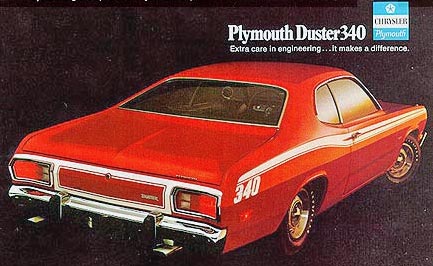
For 1971, the camshaft on automatics had a 268° intake and 276° exhaust opening duration, with 44° overlap (manuals had 276° intake, 284° exhaust, 52° overlap). Valve lift was 0.430” intake, and 0.445” exhaust.
| 1971 specs | Four-barrel | 3 x Two-barrel** |
|---|---|---|
| bhp (gross) | 275 @ 5000 rpm | 290 @ 5,000 |
| hp (net) | 235 @ 4,400 | 250 @ 4,800 |
| Lb-ft (gross) | 340 @ 3200 | 345 @ 3,400 |
| Lb-ft (SAE) | 305 @ 2,800* 310 @ 3200* | 325 @ 3,400 |
| Cam | 268° - 276° - 44° | |
* 1971 press release stated 305 lb-ft net at 2800 rpm, 1971 brochure listed 310 @ 3200.
** These engines were never actually built, but press releases showed the claimed net power and torque ratings
The engine color changed from orange to blue by the 1972 model-year—possibly changing late in the 1971 model year.
| 1971 Gross | CID | BHP Range |
|---|---|---|
| Challenger | 340 | 275 |
| Mustang | 351 | 250/300 |
| Camaro | 350 | 250/300 |
| Javelin | 360 | 245/290 |
| Cougar | 351 | 300 |
| Firebird | 350 | 265/325 |
Gross power ratings for Challenger/’Cuda competitors for 1971. Notice that every number ends with a 0 or a 5, suggesting that Marketing had a substantial impact on the data. Keep in mind that Mopar’s numbers were probably lowered from reality.
The 340 was detuned to meet 1972 model-year emissions rules, with compression dropping down to 8.5:1, and the intake valves downsized from 2.02” to 1.92” (exhaust valves stayed at 1.88”). The compression drop required a change to the wrist pin location. To save money, the crankshaft was changed from a forged unit to a cast design, possibly in April 1972, as they switched to a milder cam; a new shot-peened version of the cast crank replaced the 1972 part for the 1973 model year, due to reliability problems.
The 340 was still the LA power king, with 240 net horsepower and 290 lb-ft of torque; by comparison, its bigger sibling, the 360, was rated at 175 hp and 285 lb-ft. (For 1973, for undisclosed reasons, torque in the 360 rose to 290 lb-ft.)
The 340 did not make it into the 1974 cars, but it did give its cam and some other parts to a high-performance 360 which replaced it. Thus equipped, the 360 did an admirable job of providing 340-grade power, though today it’s rarely considered to have been a high-performance engine. But, then again, the 340 was always and only high performance, while most the 360’s life was spent as an ordinary, regular-gasoline workday powerplant.
Much of this article was based on an existing Allpar story. The information has been reorganized, corrected, and augmented. The Allpar story included key contributions from Daniel Stern, Michael Volkmann, H. David Braew, Mike Sealey, Danny Frost, Carl Payne, Josh Skinner, Steve Silver, Steve Havens, Jim Forbes, and Peter Duncan; this version includes hefty contributions from John Rush and a big dose of Willem Weertman’s book Chrysler Engines.
Copyright © 2021-2025 Zatz LLC • Chrysler / Mopar car stories and history.
YouTube • Editorial Guidelines • Videos